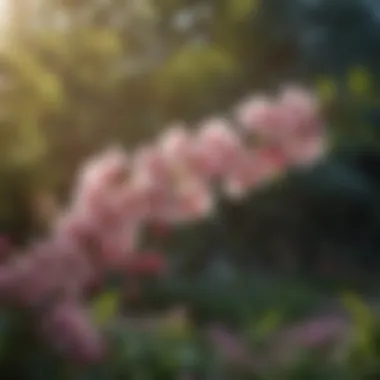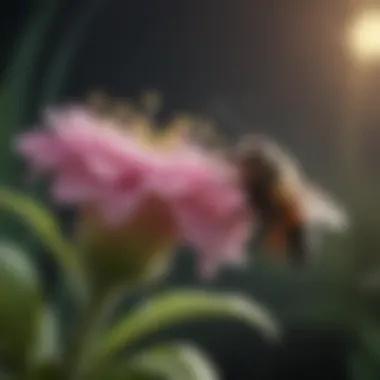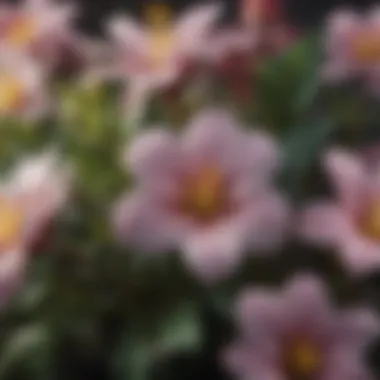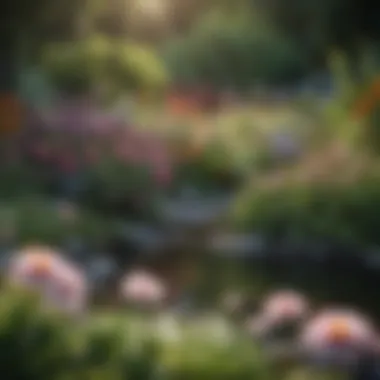Exploring the Allure of Strong Fragrant Flowers


Intro
Flowers have captured human attention throughout history. Their vibrant colors and pleasing aromas draw us in. Of these, strong fragrant flowers hold a special prominence, both in nature and human culture. This article delves deeper into such flowers, uncovering their ecological roles and cultural significance. Beyond their beauty, these flowers play a vital part in our environment.
In this exploration, we look at various species and their unique characteristics. The relationships between these plants and their pollinators reveal important interactions in our ecosystems. Additionally, practical advice will be provided for gardening enthusiasts wishing to cultivate these aroma-rich plants.
Understanding strong fragrant flowers enriches our knowledge of the natural world. Their scents are not only pleasant; they often signal the presence of essential interactions between flora and fauna. This sets the stage for deeper discussions about their biological and ecological importance.
Fascinating Facts About Strong Fragrant Flowers
Unique Characteristics
Many fragrant flowers are known for their striking blooms. For instance, the Jasmine, with its delicate white petals, exudes a sweet scent that is often associated with tranquility and romance. Roses also come in various scents, from sweet to citrusy, showcasing the vast array of fragrances found in flowers. Each species has its unique chemical makeup, contributing to its distinct smell. This variability often influences pollinators' visits, ensuring survival through reproduction.
Environmental Adaptation
The scents produced by these flowers serve practical purposes. They attract specific pollinators, including bees, butterflies, and birds. These relationships are reciprocal; while flowers entice pollinators with their fragrance, these creatures facilitate the pollination process. Plants like Lavender adapt their fragrance levels based on environmental conditions, making them more potent in warm weather, heightening their effectiveness in attracting pollinators during critical growth periods.
Cultural Significance
Flowers in Folklore
Fragrant flowers are woven into the fabric of various cultures. In many traditions, such as in India, Marigold flowers symbolize auspiciousness. They are used in religious ceremonies and celebrations. Similarly, Lotus flowers hold importance in many Asian cultures as symbols of purity and enlightenment, often represented in art and literature.
Influence on Art and Literature
Artists and writers have long drawn inspiration from these natural wonders. The scent of flowers often evokes emotions that find expression in poetry and prose. For example, William Wordsworth’s references to daffodils echo the wisdom found in nature’s beauty. This connection adds multi-dimensional significance to fragrant flowers, emphasizing their role beyond just the aesthetic.
Practical Uses in Gardening
Those interested in cultivating fragrant flowers will find numerous options. Consider the following:
- Jasmine: Thrives in warm climates, ideal for fragrances in gardens.
- Gardenia: Requires specific soil conditions, providing a rich aroma.
- Lilac: Adaptable in several environments, known for its spring blooms.
For optimal growth, choose the right location, ensure proper soil conditions, and provide sufficient care. These flowers not only enhance gardens but also contribute to local biodiversity by attracting beneficial insects.
By understanding the rich significance of fragrant flowers, we can appreciate both their ecological roles and their impact on human culture. This exploration aims to inspire and inform gardening enthusiasts and readers alike, shedding light on the beauty and importance of these botanical treasures.
Preamble to Strong Fragrant Flowers
Fragrant flowers captivate the senses and hold a significant place in both ecological and cultural realms. The interplay between plants and their scents reveals much about the intricate relationships in nature. These flowers not only add beauty to our surroundings but also attract various pollinators, playing a crucial role in ecosystems.
Defining Fragrance in Flora
Fragrance in flora can be seen as a complex array of volatile organic compounds. These compounds contribute to the scent that we associate with specific flowers. Each species has a unique composition of these chemicals, resulting in distinct aromas. For example, chemical constituents like terpenes, phenolics, and aliphatic compounds interact synergistically to produce the recognizable smells of flowers like jasmine or roses.
Fragrance serves various functions in the plant kingdom. It acts as a signal to pollinators, guiding them toward blooms as a reward for their service in the plant's reproductive cycle. Furthermore, some scents can repel herbivores or attract specific insects for propagation.
The Importance of Fragrant Flowers
Fragrant flowers play numerous roles in both nature and human life. From an ecological perspective, they are vital for the survival of many species. Pollinators, such as bees and butterflies, rely on the scent emitted by these blooms for feeding and reproduction. The presence of sweet-smelling flowers increases biodiversity in an area, as they attract a variety of pollinators, helping to maintain healthy ecosystems.
In cultural contexts, fragrant flowers serve as symbols in various rituals and traditions. They have been used throughout history in art, literature, and perfume-making. The emotional responses elicited by their aromas can influence human interactions and experiences, making them valuable in therapeutic applications, such as aromatherapy.
In gardening and landscaping, selecting strong fragrant plants offers both aesthetic pleasure and practical benefits. These flowers enhance outdoor spaces, providing fragrance that transforms the atmosphere and can evoke nostalgia or joy. Understanding the significance of fragrant flowers prompts thoughtful cultivation and conservation strategies, ensuring their continued presence in our lives.
The Biology of Flower Fragrance


Understanding the biology of flower fragrance is essential for appreciating the roles that fragrant flowers play in various ecosystems and human cultures. Fragrance is not merely an aesthetic feature; it serves critical functions in attracting pollinators, deterring herbivores, and facilitating reproduction. The study of floral scent helps us to comprehend the intricate relationships between plants and their environment.
Chemical Compounds Responsible for Scent
Flowers produce aromas through a complex array of chemical compounds. These compounds include:
- Terpenes: These are responsible for many fruity and pine-like scents. They can attract specific types of pollinators.
- Phenylpropanoids: This group contributes to scents such as cinnamon and vanilla. They often play a role in the fragrance of many flowers.
- Aldehydes and Esters: Known for their sweet aromas, these compounds can be found in flowers like jasmine and rose. Their production often correlates with reproductive strategies.
The balance and combination of these chemicals give each flower its unique scent profile. Environmental factors, such as temperature and humidity, can also play a significant role in emissions of these compounds.
How Fragrance Affects Pollination
Fragrance plays a pivotal role in the ecology of flowering plants, particularly regarding pollination. Flowers attract pollinators through their distinct fragrances, tailoring their scents to attract specific species. For example, many night-blooming flowers emit stronger scents after sunset to attract nocturnal pollinators like moths.
Studies have shown the following:
- Pollinator Attraction: Flowers that produce more potent scents tend to attract more pollinators, leading to higher rates of successful pollination.
- Scent Variation: Variations in scent can signal to pollinators the availability of nectar. This helps ensure that pollinators optimize their foraging efforts.
- Competition: Flowers may also adjust their scent profiles in response to nearby flora to stand out in a crowded environment, ensuring their reproductive success.
"The fragrance of flowers is not just a pleasure for our senses, but a critical tool for survival and reproduction in the plant kingdom."
Categories of Strong Fragrant Flowers
Understanding the categories of strong fragrant flowers is essential for gardeners, landscapers, and those simply looking to appreciate the beauty of nature. Not all fragrant flowers are alike; they are generally divided into two main categories: herbaceous and woody species. Each category has distinctive characteristics, benefits, and considerations that contribute to their role in gardening and landscape design. This classification allows individuals to choose flowers that best suit their environmental conditions and personal preferences.
Herbaceous Fragrant Varieties
Herbaceous fragrant varieties are typically non-woody plants. They can be annuals or perennials and display a diverse range of scents, colors, and bloom times. These flowers often thrive in gardens, borders, and pots. Common examples include:
- Lavender: Known for its calming scent, lavender is also appreciated for attracting pollinators.
- Mint: While primarily cultivated for its leaves, mint flowers release a pleasant aroma.
- Basil: The flowering stage of basil produces small but fragrant blooms, contributing to the herb's distinct scent.
Herbaceous varieties often require less maintenance compared to woody options. They can be easily replaced as they die back in the winter and bloom again in the spring. When selecting herbaceous fragrant flowers, consider the specific growing conditions, such as soil type and sunlight exposure.
Woody Fragrant Species
Woody fragrant species, on the other hand, include shrubs, trees, and perennial plants that have a more permanent presence in the landscape. They can provide structure and design elements to gardens while also offering distinct fragrances. Notable examples include:
- Roses: Known for their romantic appeal, many rose varieties offer rich fragrances.
- Gardenias: Renowned for their creamy white flowers and sweet scent, these are often used in landscaping.
- Honeysuckle: This climbing vine produces sweetly-scented flowers that attract a variety of pollinators.
Woody plants tend to require more time and care to establish but offer long-lasting benefits. They can provide shelter for wildlife and, in many cases, can improve the aesthetic appeal of a garden year-round. When integrating woody fragrant species into the landscape, consider the plant's growth habits and potential size, ensuring they fit well in their designated spaces.
Understanding the distinctions between herbaceous and woody fragrant flowers helps in maximizing their benefits in various settings.
Notable Strong Fragrant Flowers
Fragrant flowers hold a unique place in horticulture and human culture alike. Their scents evoke emotions, memories, and associations that are deeply rooted in various traditions and practices. In this section, we explore notable strong fragrant flowers, focusing on their importance and benefits in the context of gardening and beyond.
Roses: Timeless Elegance
Roses are often dubbed the kings of flowers. Their rich history extends over thousands of years, and they have been a symbol of love and passion. The fragrance of roses varies significantly across different species and hybrids. Some exhibit sweet, delicate scents, while others can be more robust and musky.
One critical aspect of roses is their versatility. They can thrive in a range of soils and conditions, making them accessible for various gardeners. When planted in sunny locations, roses will produce optimal blooms, impacting both the garden's aesthetic and the olfactory experience.
Benefits of Growing Roses:
- Beauty: They enhance the visual appeal of any garden.
- Cultural Significance: Roses are ingrained in art, literature, and festivities.
- Pollinator Attraction: Their scent draws in bees and butterflies, important for ecosystem health.
Jasmine: Night Bloomer


Jasmine is noteworthy for its nocturnal blooms. The flower's strong scent is particularly pronounced in the evening, making it a favorite for nighttime gardens. There are different jasmine species, such as Jasminum sambac and Jasminum grandiflorum, each offering distinct aromatic properties.
Jasmine's fragrance has a calming effect, often used in aromatherapy. Additionally, it is common in perfumes and scented oils due to its sweet, exotic aroma. Furthermore, jasmine is a vital component in traditional herbal practices across various cultures.
Considerations for Jasmine:
- Climate Adaptation: Jasmine prefers warmer climates but can adapt to many environments.
- Growth Habit: It can be a climbing plant or a shrub, providing flexibility in garden design.
Gardenias: A Fragrant Favorite
Gardenias are cherished for their creamy white flowers and intense fragrance, often reminiscent of summer. They typically bloom in late spring to summer and require specific care to thrive. Their scent is strong enough to fill a garden space with floral essence, appealing to both gardeners and visitors.
However, gardenias are sensitive plants that need well-drained soil and a certain level of humidity. They can be a challenge to grow, but their rewards are significant. Gardenias are prevalent in weddings and celebrations due to their symbolic meanings of purity and refinement.
Gardenia Care Tips:
- Watering: Consistent moisture is essential, but avoid waterlogging.
- Light: Place in partial shade to full sun for best results.
Lilacs: Springtime Aroma
Lilacs are a quintessential spring flower with a nostalgic fragrance connected to many people's youth. Blooming in clusters, they come in shades of purple, white, and pink. Their scent is often described as sweet and slightly spicy, enhancing any garden’s atmosphere.
Like other fragrant flowers, lilacs attract pollinators. The sprawling nature of their branches makes them excellent additions to shrub borders or as standalone focal points in gardens. The ease of care and resilience of lilacs enhances their appeal, making them popular among both novice and seasoned gardeners.
Growing Lilacs:
- Soil Needs: Prefer well-drained alkaline soil.
- Pruning: Regular pruning after flowering promotes healthy growth and blooms.
In summary, notable strong fragrant flowers like roses, jasmine, gardenias, and lilacs offer unmatched beauty and aroma. Each has individual care requirements and cultural significance, making them worthy choices for any garden. Their impact on the senses and their role in nature further enhance their importance in horticulture.
Cultural Significance of Fragrant Flowers
Fragrant flowers hold a remarkable place in human culture, reflecting both aesthetic appreciation and deeper meanings. Their scents evoke emotions, memories, and moments that often are tied to specific events in life. This aspect of fragrant flowers is more than just about their beauty; it encapsulates the interplay between nature and human experience. In various cultures, flowers symbolize love, reverence, and hope, making them integral to celebrations and rituals.
Fragrance in Art and Literature
The connection between fragrant flowers and the arts is profound. Throughout history, artists and writers have drawn inspiration from the delicate scents and vibrant colors of flowers. For instance, in poetry, flowers often symbolize beauty and ephemerality. Renowned poets like John Keats and William Wordsworth have illustrated flowers as elements of nature that elicit deep emotional responses.
In visual art, painters like Claude Monet captured the essence of gardens filled with fragrant blooms. His works often convey a sensory experience that invites viewers to imagine the scents accompanying the visuals. The adoration for flowers permeates literature too, where characters may gift flowers to express affection or apologize, signifying reconciliation.
Given their symbolic meanings, fragrant flowers frequently occupy key roles in cultural rituals, from weddings to funerals. The traditional use of flowers, such as roses in romantic contexts or lilies in memorials, highlights the universality of flowers as a means to convey complex human emotions.
Rituals and Traditions Involving Flowers
Rituals involving fragrant flowers can be seen across cultures, demonstrating their significance in marking important life events. For instance, in many cultures, it is customary to present flowers during weddings, symbolizing love and fidelity. Lavender and jasmine are popular choices, not only for their scents but also for their associations with joy and prosperity.
In some traditions, flowers hold spiritual or religious significance. Many spiritual ceremonies use flowers to create altars or decoration. In Hinduism, marigolds are commonly offered to deities, reflecting devotion and purity. Similarly, in Buddhist practices, fragrant offerings like jasmine are made to signify respect and remembrance.
Furthermore, seasonal festivals often embrace the beauty of fragrant flowers. The blooming of cherry blossoms in Japan marks Hanami, a celebration of spring that centers around viewing the beauty of flowers. This event emphasizes community, reflection, and the transient nature of life, resonating deeply with Japanese cultural beliefs.
In summary, fragrant flowers embody significant cultural narratives and emotional connections. Their persistent presence in art, literature, and rituals underlines their value in human experience, revealing how closely we relate to these natural wonders. Thus, the allure of fragrant flowers extends beyond their beauty; it connects us with our history and collective identities.
Fragrant Flowers in Horticulture
Fragrant flowers hold a significant place in horticulture. They not only contribute aesthetic beauty but also attract pollinators, adding ecological value to gardens and landscapes. Choosing the right fragrant plants can enhance sensory experiences, offering delightful aromas that engage the sense of smell. These flowers are more than just decorative; they play a vital role in biodiversity and contribute to the health of the environment.
Selecting the Right Fragrant Plants for Your Garden


When picking fragrant plants, it's crucial to consider various elements. First, assess the climate and soil type. Different species thrive under specific conditions. For instance, the Lavender plant prefers well-drained soil and full sunlight, while Gardenias need more humidity and partial shade.
Another significant factor is the time of bloom. Some flowers, like Night-Blooming Jasmine, release their fragrance at night, while others, such as Roses, often release their scents during the day. Selecting a mix of plants that flower at different times gives a continuous fragrance throughout the growing season.
Moreover, consider the overall size and form of the plants. Some fragrant varieties can become large and bushy, while others are compact. Understanding how they fit into your garden's design is essential for aesthetic appeal. A diverse combination of strong fragrant flowers, such as Jasmine, Lilac, and Honeysuckle, can create an enticing atmosphere in any space.
Pro Tip: Plant fragrant flowers near outdoor living spaces like patios or walkways to maximize their aromatic benefits.
Caring for Strong Fragrant Flowers
Proper care is vital for strong fragrant flowers to thrive. It begins with selecting the right location based on sunlight and soil type. Ensuring your plants receive adequate water but avoiding overwatering is also essential. For example, Rosemary prefers dry conditions, while Azaleas thrive in more moist environments.
Regular pruning helps maintain healthy growth and encourages more blooms. Deadheading spent flowers not only promotes further flowering but also helps maintain the plant's energy. Fertilizing during the growing season supports vibrant growth and fragrance production, particularly for nutrient-loving varieties.
Keep an eye on pests and diseases, as fragrant flowers can occasionally attract unwanted insects. Natural solutions, like introducing beneficial insects or using organic sprays, can help mitigate these issues. Keeping the plants healthy contributes to a robust aroma, ensuring the beauty of your garden is palpable.
In summary, the integration of fragrant flowers in horticulture adds not just beauty and value but also enriches the environment.
The Impact of Climate on Flower Fragrance
Understanding the impact of climate on flower fragrance is crucial for appreciating the complexity and significance of fragrant flora. Climate influences not only the growth conditions but also the chemical processes that result in the production of scents. Different geographical locations manifest unique climates. As a result, the fragrances of plants found in these areas can vary significantly. Specific climates affect humidity, temperature, and the duration of daylight, leading to distinctive scents in flowers.
Changes in climate can also modify the ecosystems in which these flowers thrive. The bloom time may shift, influencing when pollinators, such as bees, are active. Consequently, the survival of some fragile ecosystems depends heavily on how resilient fragrant flowers are to such changes. Understanding these relationships can help horticulturists and ecologists focus their efforts on conserving flowers that are both aesthetically pleasing and ecologically significant.
How Environmental Factors Influence Scent Production
Several environmental factors contribute to how flowers produce scent. To begin with, temperature plays a pivotal role. Various studies indicate that many flowers emit more fragrance at higher temperatures. This enhanced production often coincides with the activity levels of pollinators. As flowers warm up during the day, the concentration of volatile organic compounds, which are responsible for scent, can increase, making them more enticing to insects. This is particularly relevant in subtropical and tropical regions.
Humidity also affects scent intensity. High humidity levels can help to retain the volatile compounds within the flower. In contrast, dry conditions might lead to quicker evaporation of scents, thus reducing the effectiveness of floral attraction. Additionally, sunlight and its duration impact the metabolic processes in plants, affecting scent production. This interplay suggests that changes in climate can lead to not only changes in the fragrance profiles but also potential mismatches in pollinator interactions.
Adaptations to Changing Climates
Plants display various adaptations to cope with climate changes that affect fragrance production. Some fragrant flowers can develop deeper root systems to access water during periods of drought. Others may alter their blooming times, adapting to new temperature regimes to align with pollinator activity.
Research shows that certain species are evolving faster than others due to climate-induced pressures. For instance, flowers in elevated regions might produce more scent compounds as a response to cooler temperatures. This adaptation ensures that pollinators remain attracted despite unfavorable conditions.
Moreover, genetic studies indicate how certain fragrant flowers can produce a different array of scent molecules in response to environmental stressors. It’s vital to monitor these changes, as they impact not only the flowers themselves but the ecosystems reliant on these unique aromas. Constant shifts in climate may ultimately lead to the loss of specific scents tied to biodiversity, signaling the need for concerted conservation efforts.
Understanding the interplay between climate and fragrance production remains key for developing effective strategies in horticulture and biodiversity conservation.
Culmination: The Enduring Allure of Strong Fragrant Flowers
Strong fragrant flowers captivate us and serve essential roles in our environment. Their scents influence human emotions and memory. This connection between fragrance and feelings has been acknowledged throughout history. In literature, art, and culture, fragrant flowers symbolize beauty and persistence. The allure of these flowers extends beyond their aromatic qualities, intertwining with nature’s complexities.
Fragrant flowers benefit ecosystems by attracting pollinators. Bees, butterflies, and other insects rely on these scents to locate food sources. Their role in maintaining biodiversity is critical. When these plants flourish, they support entire food webs, protecting both flora and fauna. Thus, cultivating strong fragrant flowers in gardens contributes to urban biodiversity, enhancing local ecological health.
Furthermore, fragrant flowers are significant in horticulture. Their selection and care is important for both aesthetic and functional purposes. Knowing how to grow these varieties ensures a thriving environment that pleases the senses. Practical gardening advice can encourage families and individuals to include them in their living spaces.
As we look ahead, the cultivation of fragrant flora must adapt to climate change. Understanding environmental influences on scent production will be essential for future gardeners and botanists alike. This knowledge will help us preserve these enchanting flowers and their significance. Investing in research helps ensure the survival of these species.
In summary, the enduring allure of strong fragrant flowers lies in their multifaceted roles in nature and human experience. As we appreciate their scent, we are reminded of our interconnectedness with the environment and the responsibilities we carry to protect it.
The Future of Fragrant Flora
The future of fragrant flowers is tied to several critical factors. As climate change alters growing conditions, plants must adapt to survive. Conservative planting practices could help maintain biodiversity and ensure that fragrant flowers continue to thrive.
Moreover, focusing on native species can provide ecological benefits. Native fragrant floras are more resilient to local challenges. They can withstand pests and diseases better than introduced species. This resilience helps maintain the integrity of local ecosystems, providing food and shelter for wildlife.
Educating the public on the importance of fragrant flowers is paramount. Engagement in conservation efforts can foster a deeper appreciation. Community efforts to plant these flowers can create beautiful and aromatic spaces, enhancing both urban and rural landscapes.
Furthermore, advancements in horticulture can lead to new discoveries of hybrid species. These may possess enhanced fragrances or better adaptability to various climates. Research in genetics and plant biology holds great potential for the next generation of fragrant flowers.
To summarize, while challenges lie ahead, the future of fragrant flora is not without hope. By understanding their significance and implementing best practices in horticulture, we ensure that strong fragrant flowers will continue to enrich lives for generations to come.







